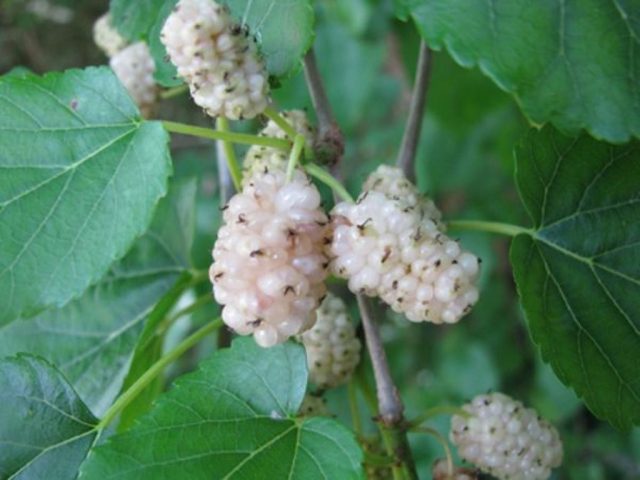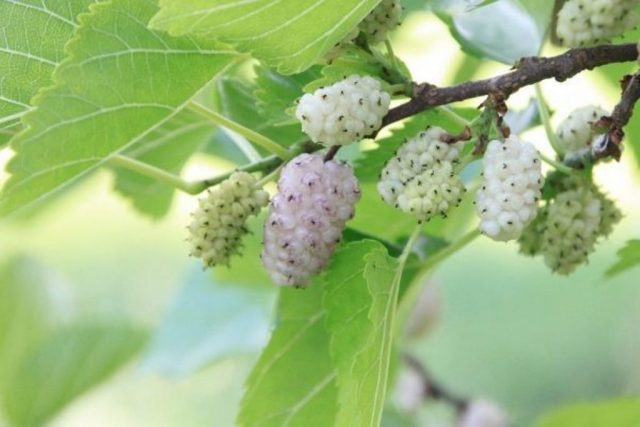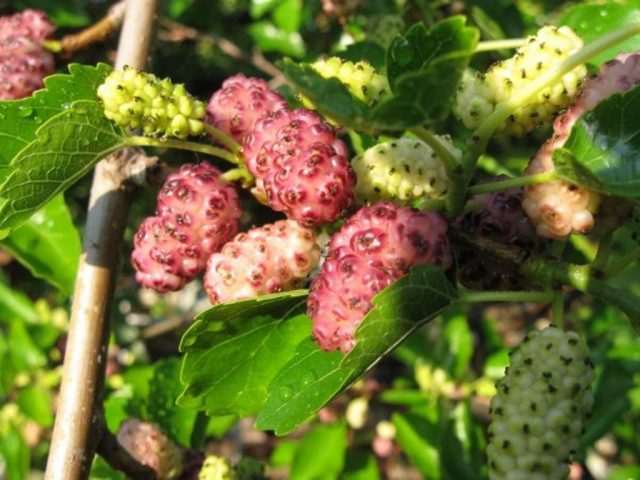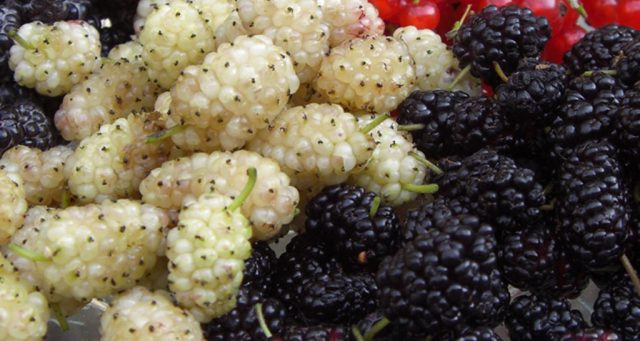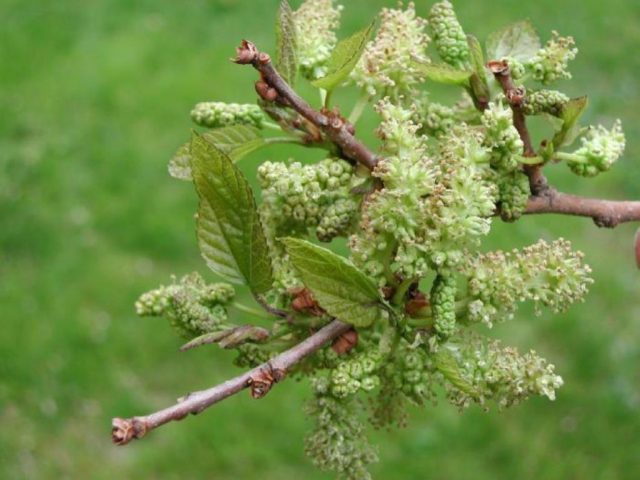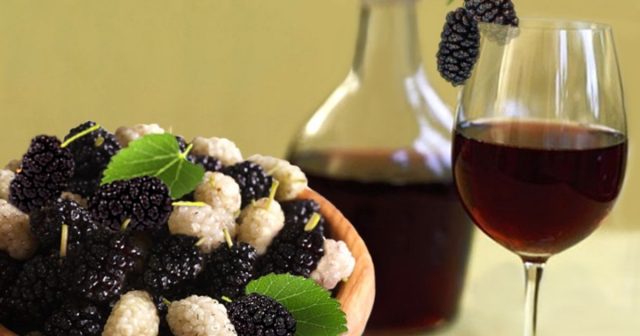Content
- 1 Botanical description of white mulberry
- 2 Description of varieties of white mulberry
- 3 White mulberry berry flavor
- 4 Why is white mulberry tree useful?
- 5 Which mulberry is tastier - white or black
- 6 How to distinguish black and white mulberries
- 7 White mulberry growing and care
- 8 How white mulberry blooms
- 9 Harvesting
- 10 White mulberry recipes
- 11 Contraindications
- 12 Reviews of white honey mulberry
- 13 Conclusion
White mulberry or mulberry tree is a fruit plant native to China. More and more often, mulberry trees can be found in the gardens of Russia, since gardeners saw not only beauty in it, but also revealed a large number of useful properties. The mulberry has gained popularity for the famous fiber from which Chinese silk is made, for its taste and medicinal qualities, and for its widespread use in cooking.
Botanical description of white mulberry
Mulberry belongs to the Mulberry family. A deciduous tree reaches a height of 15 m, forming a wide, spreading crown. Gray large branches are covered with irregular ovate leaves, which are attached with petioles up to 15 cm long. White mulberry forms two types of shoots - elongated vegetative and short fruiting ones.
The white mulberry tree can be monoecious and dioecious. Monoecious varieties form male and female inflorescences, so summer residents do not have problems with the harvest. On a dioecious mulberry, female or male flowers are formed. It is clear that in order to obtain a rich harvest, both male and female specimens must be present on the site.
It is impossible to find out the gender of the purchased white mulberry tree before flowering. If after flowering it turned out that two male or female seedlings were planted, the situation can be saved by re-grafting. To do this, 4 cuttings are cut from the fruiting mulberry and in mid-April, before flowering, they are grafted. Long vegetative shoots are selected for high-quality grafting, since fruiting shoots are not suitable for grafting.
If the cuttings were successful, it is necessary to begin the formation of the crown of the white mulberry from young shoots, gradually getting rid of the old branches. An over-grafted mulberry tree begins to bear fruit for 4 years.
Description of varieties of white mulberry
To provide yourself with a crop, you need to choose the right variety. When choosing a white mulberry tree, it is necessary to take into account the cold hardiness, ripening time, immunity to diseases and the taste of the berries. To choose the right variety, you need to read the description and view photos of the white mulberry varieties.
Mulberry White Honey
Mulberry White Honey, according to the description, photos and reviews of gardeners, is the most popular early maturing variety. Flowering occurs at the end of May, 4 years after planting. Fruiting occurs in mid-June. The mulberry tree is unpretentious in care, grows in any soil and brings a consistently large harvest. Features of the variety:
- good annual growth;
- long-liver, growing in one place for about 200 years;
- drought resistance;
- sweet taste of the fruit.
Mulberry rare White Tenderness
The most cold-resistant variety, it can withstand frosts down to -40 ° C. Mulberry White Tenderness is ideal for Russian regions with an unstable climate. It belongs to the early maturing varieties, fruiting occurs in mid-June and lasts 8 weeks. The quality and quantity of the harvest depends on the weather conditions.If the summer is sunny and warm, the fruits ripen large and sweet, in rainy weather the harvest can not wait.
Fruit-1
An early ripe variety, the first harvest ripens in mid-June. Fruiting is long-term, stretching for 6-8 weeks. White drupes appear only in dry warm weather, if the spring and early summer were rainy, the fruits are painted in a pale pink color. The yield of the variety is high. At the age of 8 years, mulberries can bear up to 150 kg of fruit. Drupes have a firm, sweet and juicy flesh. Among all varieties of white mulberry, Plodovaya -1 is stored longer and can be transported over short distances.
Pink Smolensk
An early ripening variety that forms sweet-sour pink fruits. Despite the fact that male specimens do not bear fruit, they will be a wonderful decoration for the garden. Due to its unpretentiousness, frost resistance, the variety is considered the best for beginner gardeners. The first fruiting occurs one year after planting. The mulberry tree bears medium-sized raspberry or red fragrant, sweet fruits.
Features of the variety:
- the first fruits ripen in early June;
- berries are sweet with an unforgettable sour note;
- long-term fruiting;
- frost resistance.
Merezhevo
A young hybrid bred by Russian breeders. The tree is a large-fruited variety with sugary-sweet, aromatic fruits. Mulberry fruiting occurs in the second year after planting and lasts about 30 days. Ripening begins in mid-June and lasts until the end of August. Berries 5 cm long are colored cream or pink. The variety has a drawback: when overripe, the fruits quickly crumble.
White mulberry berry flavor
The taste of the berry depends on the variety and place of growth. In dry and hot climates, large berries acquire juicy pulp and sugary-sweet taste. In regions with rainy and short summers, white mulberry produces small sweet and sour berries.
Why is white mulberry tree useful?
White mulberry berries have beneficial properties, so they are widely used in folk medicine. Each berry contains a high amount of vitamins B, PP, C, as well as a high content of carotenoids, malic and citric acid, essential oils and iron.
In order for the white mulberry tree to be beneficial, you need to know how to use it:
- drupe juice, diluted with warm water, is used to gargle with sore throat;
- decoction of the root saves from hypertension;
- an infusion of leaves relieves the temperature;
- berry infusion will relieve colds;
- a decoction of dried berries will eliminate insomnia and improve the functioning of the nervous system;
- fresh berries restore strength in the postoperative period;
- not ripe harvest saves from indigestion and heartburn;
- freshly squeezed juice treats skin diseases;
- Chopped bark mixed with vegetable oil can quickly heal cuts, abrasions and wounds.
Which mulberry is tastier - white or black
The white mulberry is less sweet and has a sweet and sour taste. Due to its low sugar content, it is ideal for dietary meals. The berry can have not only snow-white, but also pink, cream and even dark color. Due to its good frost resistance, white mulberry can be grown in any corner of Russia.
In black mulberry, the drupe is juicier and sweeter. Outwardly, they are similar to blackberries. The black type of mulberry tree can be found only in the south of Russia or in post-Soviet countries.
Also, black and white mulberries differ in chemical composition. White has a large amount of carbohydrates, while black has a high content of organic acids.
How to distinguish black and white mulberries
Black mulberry differs from the white color of the bark.If in the white species it has a gray color, then in the black one it is reddish-brown. The shoots of black mulberry are short and numerous, the leaf blade is long, from 7 to 20 cm.
Lemon male inflorescences are cylindrical, pale green female ones are oval. Black mulberry fruits have a loose structure and are colored black or purple. Unlike white mulberries, black berries contain a lot of sugar, have a refreshing taste and aroma.
White and black mulberry trees got their name not because of the color of the drupes, but because of the color of the bark.
White mulberry growing and care
White mulberry is an unpretentious, frost-resistant plant. Even a novice gardener can easily grow it, since it is drought-resistant, it can grow and develop on any soil. The cultivation of white mulberry is to follow the rules of care.
Landing rules
White mulberries are planted in mid-spring before sap flow or in September before the rainy season. Most gardeners prefer autumn planting, because if the mulberry tree can endure the winter well, then it will have a long life.
The landing site should be bright, protected from gusty winds.
It is possible to determine the sex of the mulberry only after flowering, so it is better to purchase a 3-year-old seedling that has already borne fruit.
A planting pit for mulberries is prepared 10-15 days before planting a seedling. To do this, dig a hole 70 cm deep, 50 cm wide. A drainage layer and 7 kg of rotted humus mixed with 100 g of superphosphate are placed on the bottom. So that the roots of the white mulberry do not get burned, sprinkle humus with a layer of nutritious soil. The prepared hole is poured abundantly to settle the earth.
Landing rules:
- At the appointed time, the root system of the white mulberry is straightened, the dried and damaged roots are removed to healthy tissue.
- The mulberry tree is placed in the center and carefully covered, periodically shaking the trunk so that an air cushion does not form.
- After planting, the top layer is tamped, the earth is abundantly shed and mulched.
- If the young mulberry is fragile and has a thin trunk, before planting, a support is driven into the bottom of the pit, to which the seedling is tied.
The spring planting of white mulberries is no different from the autumn, the only difference is that the land is prepared in the fall.
Watering and feeding
White mulberry is a drought-resistant plant. Moderate watering is carried out from April to June, only in dry weather. If the spring was rainy, summer watering is excluded. Irrigation is carried out in a volume of 10 liters per 1 adult plant. After watering, the soil around the near-stem trunk is carefully loosened and mulched. Mulch will retain moisture, stop the growth of weeds, become an additional fertilizer and protect the root system from freezing.
Young white mulberries do not need to be fed before fruiting. Since the nutrients introduced during the preparation of the planting pit will be enough for the mulberry tree to grow and develop. But at the fruiting stage, feeding should be carried out regularly and in a timely manner:
- In early spring, before bud break, dissolve 50 g of nitroammophoska in a bucket of warm water. This composition is enough to feed 1 plant.
- At the beginning of flowering - chicken manure is mixed with water in a ratio of 1:12.
- In late autumn, after leaf fall, phosphorus-potassium fertilizers are applied. Autumn feeding is necessary to give strength after fruiting and to protect the root system from severe frosts.
Pruning
Pruning of white mulberries is carried out in spring and autumn.
Spring pruning - performed before the leaves open. The trunk of a young mulberry tree is exposed to a height of 1.5 m, removing all branches so that they do not touch the ground with age.When forming the crown, you can leave 1 conductor, or you can let the plant grow freely.
If the task is to grow a small white mulberry, then pinch the top at a height of 170 cm.The skeleton begins to form from 8 lateral shoots. In subsequent years, pruning of white mulberry is carried out only to give an aesthetic appearance. All excess, damaged and dried shoots are removed. The drooping branches are not cut out; props are installed for them.
Autumn pruning - after falling leaves, white mulberries are prepared for winter. To do this, make a sanitary pruning, cutting out dry, damaged, too thin and growing deep into the crown of the branch.
The crown of the white mulberry can be formed in the form of a ball or panicle. To give the shape of a ball, the lateral lower branches are shortened by ⅓ of the length, the middle ones by ¼. From the middle of the future ball, pruning is carried out in the reverse order.
The shape of the panicle is easy to form. For this, the central shoot is not isolated from the mulberry, but the shoots are trimmed at the same height.
To give a weeping look, pruning is carried out on the lower and lateral buds. With this pruning, the mulberry branches will bend downward. When creating such a form, a strong pruning is carried out to the detriment of the crop.
Protection against diseases and pests
To protect the mulberry tree from diseases and insect pests, it is necessary to regularly carry out preventive measures. Not only the crown of the tree, but also the trunk circle is treated with insecticides and fungicides.
Processing of white mulberry is carried out before bud break and in late autumn, after the end of the growing season. A 3% Bordeaux mixture solution will help protect the mulberry tree from diseases and pests. In the spring, mulberries can be treated with a 7% urea solution. It will not only destroy pests and pathogenic microorganisms, but also enrich the root system with nitrogen.
Preparing for winter
White mulberry firmly tolerates severe frosts, therefore, an adult specimen is not given shelter for the winter. Only young white mulberries are recommended to cover. To do this, after the autumn pruning and feeding, the trunk circle is mulched, and the flexible branches are bent to the ground and covered with non-woven material. The same material is used to wrap the trunk of a mulberry tree to protect it from rodents.
How white mulberry blooms
If the mulberry is planted in early spring, then the sex of the plant can be determined during flowering. Female spike-shaped inflorescences form short and dense earrings. Each flower is formed by a pistil, stamens and a 4-leafed light green perianth. The male flower forms looser earring inflorescences. The flower consists of a 4-leafed perianth and 2 pairs of stamens.
Harvesting
The yield of the mulberry tree is high; up to 100 kg of fruit can be removed from an adult specimen. It is impossible to hesitate with harvesting, as the overripe berry quickly crumbles. Drupes are collected from mid-June to late August. Cleaning is done early in the morning, on a sunny, not rainy day. In order not to lose the harvest, a blanket or a large piece of polyethylene is spread under the crown of the tree. After that, they tap on the branches with a stick, thereby provoking the shedding of the berries.
After the end of the work, the drupes from the film are carefully collected in a separate container. In this case, you need to remove leaves, branches and other debris. The shelf life of white mulberry is short; in a cool place, it can lie no more than 2-3 days. Therefore, it needs to be eaten and processed. Delicious, aromatic jam, healthy compotes and jams are made from white mulberry. Freshly picked drupes can be frozen or dried.
White mulberry recipes
The medicinal properties and contraindications of white mulberry have been known since ancient times. Therefore, when growing a mulberry tree on your site, it is necessary to learn about contraindications and consult a therapist when you first use the berries.
White mulberry jam
To prepare a tasty and aromatic delicacy, you will need:
- white mulberry - 1 kg;
- sugar - 1.3 kg;
- lemon - 3 pcs.
Step by step execution:
- Freshly picked mulberries are carefully sorted out.
- Lemons are washed and scrolled together with the peel through a meat grinder to make lemon gruel.
- Drupes are combined with lemon, covered with sugar and left for 3 hours to obtain juice.
- Prepared jam is put on low heat until boiling.
- Remove the pan to cool completely.
- Then they are returned to the stove and boiled for 30 minutes.
- The procedure is carried out 2 times.
- The finished jam is cooled and transferred to clean jars.
Mulberry compote
For cooking you will need:
- white mulberry - 450 g;
- sugar - 350 g;
- citric acid - 1 tsp
Recipe:
- Drupes, along with the stalks, are placed in a sterile jar, covered with sugar, citric acid is added and boiled water is poured to the shoulders.
- After filling, the jars are closed with sealed lids and turned upside down.
- To cool the compote slowly, cover it with a warm blanket and leave it overnight.
- The cooled drink is stored in a cool place.
Pouring
To prepare the liqueur, prepare the following ingredients:
- white mulberry and sugar - 1 tbsp each;
- water - 100 ml;
- vodka - 200 ml.
Preparation:
- Sugar is poured into the water and brought to a boil.
- The mulberry is sorted out and kneaded with a wooden pestle until puree.
- The berry mass is transferred to a glass container and poured with sweet, hot syrup.
- The bottle is left at room temperature until it cools completely.
- Vodka is added to the cooled drink, covered with a lid and removed for infusion in a dark place for 2 weeks.
- After 14 days, the liqueur is filtered and stored in a dark, cool room.
Contraindications
Despite the fact that white mulberry has a large number of useful properties, it should not be overused. Since when consumed excessively, especially in hot weather, mulberries can cause a sharp jump in blood pressure and indigestion. Drupe is not recommended to be eaten in combination with other fruits and berries, as the juice causes intestinal fermentation. Therefore, it must be consumed 3 hours before or after meals.
Reviews of white honey mulberry
Conclusion
White mulberry is a healthy, fast-growing plant that can be grown in regions with unstable climates. Thanks to the beneficial properties, with the help of berries, you can quickly cope with many ailments. But do not forget that mulberry, like other berries, has contraindications. Before the first use of the fruit, you need to consult a specialist.
